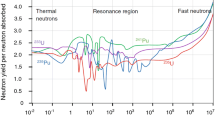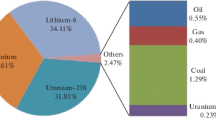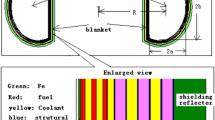Abstract
In this study, the improvement of neutronic performance of a dual purpose modified PACER concept has been investigated. Flibe as the main constituent are fixed as 92% coolant. ThF4 is mixed with increased mole-fractions of RG-PuF4 starting by 0 mol % up to 1 mol %. TBR variations for all the investigated salts with respect to the RG-PuF4 contents are computed. Tritium self-sufficiency is provided with the ThF4 when the adding RG-PuF4 content is higher than 0.75%. The energy multiplication of the blanket is increased as 70% with adding RG-PuF4 contents to ThF4. High quality fissile isotope 233U are produced with increasing RG-PuF4. DPA and helium production increases with increased RG-PuF4 content in molten salt. Radiation damage with dpa <1.7 and He <3.3 ppm after a plant operation period of 30 years will be well below the damage limit values.
Similar content being viewed by others
Avoid common mistakes on your manuscript.
Introduction
Nuclear fusion is an alternative energy source. Nuclear fusion could provide a cheap, environmentally benign, and inexhaustible energy. Nowadays, magnetic confinement fusion (MCF), inertial confinement fusion (ICF) technologies are studied. However, MCF and ICF fusion reactors have some problems such as plasma physics and materials technology. On the other hand, the use of nuclear explosives can produce a significant amount of energy. The obtained energy can be converted into electricity via a nuclear fusion power plant. The idea of producing electricity through peaceful nuclear explosive (PNE) was proposed by some researchers in 1960’s [1–10]. This idea is called as PACER fusion concept [1–3]. PACER fusion concept has an underground containment vessel to handle the nuclear explosives safely. The detail information about the PACER concept can be found in [1–3]. The working fluid is Li2BeF4 (Flibe). In molten salt zone, Flibe is a liquid volume fraction of 25% and void volume fraction of 75%. In previous study, the modified PACER concept was used for the production of valuable fissile isotopes via reactions of fertile isotopes. In PACER fusion concept with Flibe coolant, Flibe + ThF4 or UF4 and various ThF4/233UF4 molten salts were performed for energy multiplication and fissile fuel breeding by some researchers [11–16].
In this study, the improvement of the neutronic performance of the PACER fusion concept are investigated. The effect of the adding reactor grade (RG)-PuF4 content in ThF4 + Flibe molten salt are investigated and compared as regards tritium breeding ratio (TBR), energy multiplication (M) and fissile fuel breeding. In addition, displacement per atom (DPA) and helium gas production are computed.
Blanket Structure
A one-dimensional model of the blanket for the neutronic calculations is shown in Fig. 1 [1–3, 13, 14]. The peaceful nuclear explosive (PNE) device is located in a spherical cavity with a radius of R = 5 m. The explosion yield is 2 kt (8.36 TJ) every 40 min which produces a fusion power of 3,780 MWth [1–3, 11–13] in a 20 m radius cylindrical cavity. However, I have assumed the fusion neutron source to be entirely 14.1 MeV. The molten salt zone consisting of liquid jets has a radial thickness of DR = 2 m. The basic constituent of molten salt is Flibe. In the present study, molten salts form of mixed ThF4/RG-PuF4 has been added to Flibe for the purpose of improvement neutronic performance. The molecular fraction are taken 8% (Th/RG-Pu)F4 and 92% Flibe coolant. The molecular fraction of the flibe is fixed. However, RG-PuF4 is gradually increased from 0 up to 1% in the coolant whereas; ThF4 is gradually decreased in the coolant. The cavity is lined with 1 cm-thick stainless steel of type SS-304. SS-304 steel structures have been selected. After the liner, a 50 cm rock zone is used to consider the neutron reflection back into the cavity [11–16].
Calculation Methods
Neutron transport calculations are performed in spherical geometry with the help of SCALE 5 SYSTEM [17] in S8-P3 approximation using the code XSDRNPM [18] and the 238 groups library [19], derived from ENDF/B–V. The resonance self-shielding weighted cross sections are processed with the help of the CSAS control module [20] using BONAMI [21] for the unresolved resonances and NITAWL-II [22] for the resolved resonances. Integration of the angular neutron flux is made in the S8–P3 approximation by using Gaussian quadratures.
Numerical Results
Neutronic calculations have been performed for the following five cases: 8%ThF4, 7.75%ThF4 + 0.25% RG-PuF4, 7.5%ThF4 + 0.5% RG-PuF4, 7.25%ThF4 + 0.75% RG-PuF4, 7%ThF4 + 1% RG-PuF4 in molten salt zone. Flibe in molten salt zone are taken as 92%. Tritium breeding ratio (TBR) to maintain tritium self-sufficiency of the (D-T) fusion reactor is must be more than 1.05. TBR variations have been performed for five cases. Figure 2 shows the TBR variations for all the investigated salts with respect to their RG-PuF4 contents of the salts at start-up of the reactor. It can be seen that TBR increases with an increase in the plutonium content. If the TBR limit is taken as 1.05, the RG-PuF4 contents in the salt should be greater than 0.75% for tritium self-sufficiency. Total fission rate (Σf) increases with increasing RG-PuF4 contents in the salt in the blanket as shown in Fig. 3. The increased fission reactions affect TBR values in molten salt zone.
The energy multiplication factor is defined as the energy generation deposited in the molten salt zone the incident neutron energy. It can be calculated as below:
The fission reaction of plutonium in molten salt zone leads to a significant increase in the energy multiplication (M) of the blanket. The M values are 1.305 for molten salt zone using 8% ThF4 whereas; the values are 2.033 for 7.25% ThF4 + 0.75% RG-PuF4 molten salt at start-up of the reactor. The main contributions to energy multiplication are maintained from the fission of plutonium isotopes and the exothermic 6Li(n,γ)T reaction. Increasing Σf affects the (M) in the blanket. As a result, the M values with Flibe + (Th/RG-Pu)F4 is higher than that Flibe + ThF4. The M is increased as 70% with addition of 0.75% RG-PuF4 nuclear fuel in the molten salt. It can be seen that M increases with increased RG-PuF4content as illustrated in Fig. 4.
In the molten salt region, the fertile isotope 232Th converts to a high quality fissile isotope 233U by capturing a neutron. The increasing RG-PuF4 contents in the salt leads to a significant increase the fissile fuel breeding in the blanket. Fissile isotopes of 233U can be generated by the (n,γ) reaction of the fertile isotopes. The net 233U production with the 8% ThF4 + 92% Flibe in the salt is 2,860 kg/year. However, the 233U production with the 7.25% ThF4 + 0.75% RG-PuF4 + 92% Flibe in the salt becomes 2,870 kg/year for a full power year.
In the power plant, the only steel liner at the periphery of the cavity is exposed by nuclear radiation as shown in Fig. 1. The DPA and helium gas generation are investigated for the steel exposed to nuclear radiation. Ref. [23] suggests a DPA value of 165 for SS-316. However, in this work, the limit DPA value of 100 is assumed. I have calculated DPA values between 1.343 and 1.623 at the steel liner for the investigated (Th/RG-Pu)F4 and flibe coolant mixture range. Refs. [23, 24] suggest a helium production limit of 500 appm in steel. I have calculated helium production values below 3.257 and 3.283 ppm at the liner. It can be seen that DPA and helium production increases when RG-PuF4 content is increased. However, displacement per atom (DPA) and helium gas production after a plant operation period of 30 years will not cause a material damage at the SS-304 steel.
Conclusions
The main conclusions for this study can be given as below:
-
Tritium self-sufficiency is provided with the ThF4 and Flibe coolants when the adding RG-PuF4 content is higher than 0.75%.
-
The energy multiplication of the reactor is increased with adding RG-PuF4 contents to ThF4 and Flibe.
-
Among investigated molten salts, the suitable ratio is 92% Flibe + 7.25% ThF4 + 0.75% RG-PuF4 as regards the tritium self-sufficiency.
-
DPA and helium production increases with increased RG-PuF4 content in molten salt. DPA and helium gas production will not cause a material damage in this study.
-
The adding RG-PuF4 in molten salt could be increased the neutronic performance compared to the coolants Flibe [13], Flibe + UF4 or ThF4 [14].
References
C.J. Call, R.W. Moir, Nucl. Sci. Eng. 104, 364 (1990)
A. Szöke, R.W. Moir, Technol. Rev. 94, 20 (1991)
A. Szöke, R.W. Moir, Fusion Technol. 20, 1012 (1991)
R.W. Moir, Fusion Technol. 15, 1114 (1989)
Engineering with nuclear explosives, in Proceedings of the 3rd Plowshare Symposium, TID-7695 (U.S. Department of Energy/Office of Scientific and Technical Information, Oak Ridge, 1964)
E. Teller, W. Talley, G. Higgins, Constructive uses of nuclear explosives (McGraw-Hill, New York, 1968)
H. W. Hubbard, Project PACER Final Report, RDA-TR-4100-003 (R&D Associates, 1974)
W. Seifritz, Fusion 4, 22 (1980)
R.P. Hammond, Mech. Eng. 104, 34 (1982)
V. David, Trans. Am. Nucl. Soc. 56, 127 (1988)
S. Şahin, H.M. Şahin, K. Yıldız, A. Acır, Kerntechnik 70, 233 (2005)
S. Ünalan, Fusion Eng. Des. 70, 233 (2004)
S. Şahin, R.W. Moir, S. Ünalan, Fusion Technol. 26, 1311 (1994)
S. Şahin, s. Şahin, K. Yıldız, Fusion Eng. Des. 65, 643 (2003)
S. Ünalan, S.O. Akansu, Arab. J. Sci. Eng. 29, 27 (2004)
A. Acır, M. Übeyli, J. Fusion Energ. 29, 113–118 (2010)
L. M. Petrie, Scale system driver, NUREG/CR-0200, Revision 7, Volume III, Section M1, ORNL/NUREG/CSD-2/V3/R7, 19 May 2004 (Oak Ridge National Laboratory, Oak Ridge, 2004)
N. M. Greene, L. M. Petrie, XSDRNPM: a one-dimensional discrete—ordinates code for transport analysis, NUREG/CR-0200, Revision 7, Volume 2, Section F3, ORNL/NUREG/CSD-2/V2/R7 (Oak Ridge National Laboratory, Oak Ridge, 2004)
W. C. Jordan, S. M. Bowman, D. F. Hollenbach, Scale cross-section libraries, NUREG/CR-0200, Revision 7, Volume 3, Section M4, ORNL/NUREG/CSD-2/V3/R7 (Oak Ridge National Laboratory, Oak Ridge, 2004)
N. F. Landers, L. M. Petrie, D. F. Hollenbach, CSAS, control module for enhanced criticality safety analysis sequences, NUREG/CR-0200, Revision 6, Volume 1, Section C4, ORNL/NUREG/CSD-2/V1/R7 (Oak Ridge National Laboratory, Oak Ridge, 2004)
N. M. Greene, BONAMI, resonance self-shielding by the Bondarenko method, NUREG/CR-0200, Revision 6, Volume 2, Section F1, ORNL/NUREG/CSD-2/V2/R7 (Oak Ridge National Laboratory, Oak Ridge, 2004)
N. M. Greene, L. M. Petrie, R. M. Westfall, NITAWL-III, scale system module for performing resonance shielding and working library production, NUREG/CR-0200, Revision 6, Volume 2, Section F2, ORNL/NUREG/CSD-2/V2/R7 (Oak Ridge National Laboratory, Oak Ridge, 2004)
A. Blink, W. J. Hogam, J. Hovingh, E. R. Meier, J. H. Pitts, High-Yield Lithium-Injection Fusion Energy (HYLIFE) Reactor, UCRL-53559, ed. by K. L. Essary, K. E. Lewis (Lawrence Livermore National Laboratory, Livermore, 1985)
M. Perlado, M. W. Guinan, K. Abe, Radiation Damage in Structural Materials, Energy from Inertial Fusion (International Atomic Energy Agency, 272, Vienna, 1995)
Author information
Authors and Affiliations
Corresponding author
Rights and permissions
About this article
Cite this article
Acır, A. Improvement of the Neutronic Performance of the PACER Fusion Concept Using Thorium Molten Salt with Reactor Grade Plutonium. J Fusion Energ 32, 11–14 (2013). https://doi.org/10.1007/s10894-012-9518-4
Published:
Issue Date:
DOI: https://doi.org/10.1007/s10894-012-9518-4








